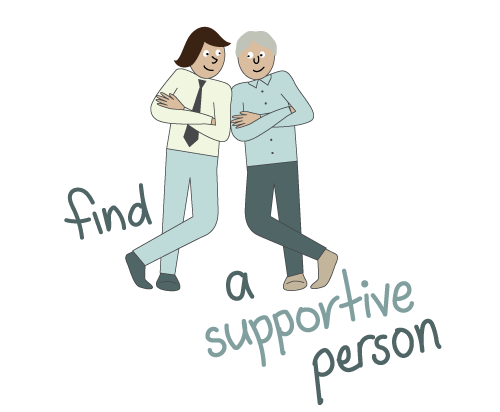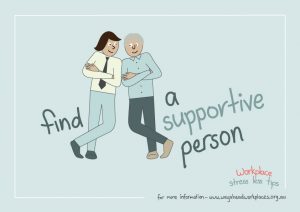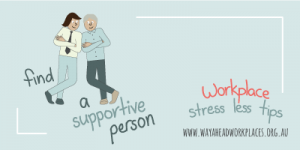
Find a supportive person in your workplace to talk to
We rely on our colleagues for advice, support, networks and social connection. According to this study, those who have good relationships with co-workers have better physical and mental health and reduced risk of burnout. If concerned about someone at work, make a regular time to check in with them or encourage them to speak with their manager, HR or health professional.
Actions – Individual
Set up the conversation
- When wanting to check in with a colleague, find a quiet moment to talk in private – suggest going for a walk outside of the office
- Open up your body language by relaxing shoulders and uncrossing arms
- Practice active listening by nodding and acknowledging what they are saying
- Be mindful of your choice of words and tone of voice
- Minimise distractions, including screens and phones
During difficult conversation
- Take an active interest and ask open-ended questions like, “How are you doing?” to try and understand how the other person is feeling
- Unless someone specifically asks for your advice, it’s best to withhold your opinions
- If someone shares something personal, acknowledge their openness and trust in you
- Make specific offers, rather than just asking “How can I help?”, to make it easier for the other person make a choice and to help you set boundaries and not feel overloaded
- If needed, ask others for help after getting consent from the person needing support
- If the other person is open to it, help them reframe their situation, break it into manageable chunks, and make a plan of action
- If appropriate, encourage the person to take time to better care for themselves, which may include exercising, eating well, getting involved in social activities and speaking with a doctor or psychologist
Actions – Team
- Refer people to resources at work, such as an Employee Assistance Program (EAP) if you have one and, if appropriate, offer to help make an appointment
- Suggest they seek support and talk through different options
- Discuss with the employee what, if anything, they would like others to be told about their situation and how it is conveyed
- If adjustments to someone’s work have been made, communicate changes with the rest of the team in a way that protects the employee’s privacy
- Manage absences where required and review workloads of other team members to ensure they are not unfairly burdened by changes
- Work with the employee to form an agreement about what kinds of communication, if any, are shared with them during longer periods of leave
- Support employees on their return by working together to set up an individualised return to work plan
Actions – Organisation
Set up your workplace
- Ensure your organisation has return to work policies that cover mental, as well as physical, illness
- Review your organisation’s existing mental health awareness programs and their effectiveness
- Talk about mental health without judgement
- Start your meetings/conversations with a wellbeing check-in
Seek expert advice on supporting employees
- Engage human resources specialists, occupational rehabilitation providers or Employee Assistance Programs (EAP) that may be available to the business
- Obtain written permission from the employee to speak with their treating health professional about how the workplace can support their recovery
Engage your staff
- Explore the possibility of making reasonable adjustments to support an employee to stay at work before assuming they will need time off
- Consider implementing empathy training workshops or consult your Employee Assistance Program, if you have one, for guidance
- Increase managers’ confidence and skills, and wider mental health literacy, by offering Mental Health First Aid training to all staff
- Utilise coaching for managers on maintaining good relationships with their staff
Activity ideas
- RUOK at work
- 10 Creative Ways Organisations are Supporting Employee Mental Health Remotely
- Helping a Coworker Who’s Stressed Out – Harvard Business Review
- Helping a Team Member With Stress – Bupa
- How to Have More Empathy: Learn the Four Attributes of Empathy From Brené Brown – Melli O’Brien
- How to Improve Your Relationships at Work – Forbes
- How to Offer Support to a Grieving Colleague – Harvard Business Review
- How to Support a Colleague with Anxiety – Bupa
- How to Support Employees Through Grief – Altius Group
- Supporting a Colleague with Cancer – Cancer Council
- Supporting Someone at Work – Beyond Blue, The Mentally Healthy Workplace Alliance, and Heads Up
- The Art of Being a Great Coworker: 13 Ways to Improve Your Work Relationships – Hubspot
- Tips for Better Conversations with Men – MensLine Australia
Research
- Do You Need a Friend at Work? – Dr Jenny Brockis
- How Investing in Caring for Others Helps Us All – Dr Jenny Brockis
- Want to Improve Your Relationships? – Michelle McQuaid
- Work Wives and Husbands, Research Says You Need One – HRM (Australian HR Institute)
- Ending Loneliness Together White Paper
Resources
- Conversations Matter Professional Resources – Everymind
- Practical Steps Leaders Can Take to Drive the Disability Inclusion Agenda – Australian Network on Disability
- Supporting Co-Workers – Australian Government, Department of Health, Head To Health
- Supporting Others – Beyond Blue, The Mentally Healthy Workplace Alliance, and Heads Up
TED talks
- Building a Psychologically Safe Workplace – Amy Edmondson
- The Critical Importance of Friends on Your Happiness – Mike Duffy
- Why Good Leaders Make You Feel Safe – Simon Sinek
Downloadables
Click on each image and when it opens, right click and select ‘Save image as…’
A4 individual tip

eSignature
Please hyperlink it with https://workplaces.wayahead.org.au/workplace-stress-less-tips/




